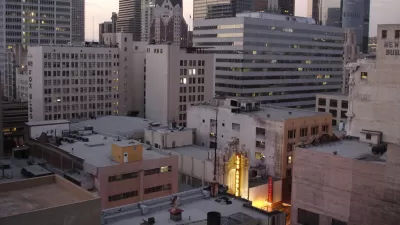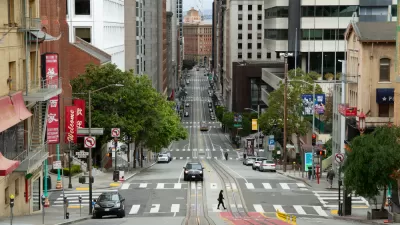Urban cores around the country were transforming into live, work, and play destinations before the pandemic. The pandemic was a setback for this transformation, but it could also be a rare opportunity. It’s up to city leadership to seize it.

“The nation is in the midst of one of the biggest workforce shifts in generations,” writes the Washington Post Editorial Board, describing the effects of nearly three years of stay-at-home orders, working from home, and hybrid work schedules. “Many now have experienced what it is like to work from home and have discovered they prefer it.”
While much of the discussion in cities has focused on the fiscal distress caused by office vacancies, the loss of demand for retail uses in urban cores, declining transit ridership, and shifting commute patterns, less frequently addressed is the opportunity to, for lack of a better phrase, build back better—to turn the crisis of downtown vacancies into an opportunity to solve some of the challenges facing downtowns and regions since even before the pandemic.
The Washington Post writes to refocus the discussion on the opportunities, identifying two obvious opportunities—to return workers to offices and to convert commercial spaces to residential units and entertainment venues.
“This is a once-in-a-generation opportunity to reshape downtowns for the future. It should be a top priority of mayors and city councils around the country,” according to the editorial. “The goal is a ‘24/7’ downtown with ample work spaces, apartments, parks and entertainment venues that draw people in during the day and have a core of residents who keep the area vibrant after commuters go home.”
While that kind of downtown environment was becoming more common in many U.S. cities before the pandemic, many cities had a long way to go in attracting the residential population required to provide a “24-7” downtown.
According to the editorial, both priorities will face substantial challenges, overcome by political will and creative thinking. On the theme of workers returning to the office, D.C. Mayor Muriel Bowser recently called on President Joe Biden to return federal workers to offices for the sake of D.C.’s downtown. New York Mayor Eric Adams has also been a vocal proponent for returning to the office. According to the editorial, workers are already returning to the office, but it’s unlikely they will ever return to pre-pandemic levels. For the foreseeable future, downtowns will be oversupplied with office uses.
So adaptive reuse will be necessary. The editorial identifies a growing interest by developers to begin conversion projects, but multiple hurdles remain. The Washington Post suggests specific actions that can make the most of the opportunity, including setting clear goals for new residents in downtown, speeding up permitting for adaptive reuse projects, creating new financing mechanisms, and thinking beyond housing. More detail on each of these suggestions are available in the source article below.
FULL STORY: Downtowns are lifeless. It’s a once-in-a-generation chance to revive them.

Planetizen Federal Action Tracker
A weekly monitor of how Trump’s orders and actions are impacting planners and planning in America.

Map: Where Senate Republicans Want to Sell Your Public Lands
For public land advocates, the Senate Republicans’ proposal to sell millions of acres of public land in the West is “the biggest fight of their careers.”

Restaurant Patios Were a Pandemic Win — Why Were They so Hard to Keep?
Social distancing requirements and changes in travel patterns prompted cities to pilot new uses for street and sidewalk space. Then it got complicated.

Albuquerque Route 66 Motels Become Affordable Housing
A $4 million city fund is incentivizing developers to breathe new life into derelict midcentury motels.

DC Area County Eliminates Bus Fares
Montgomery County joins a growing trend of making transit free.

Platform Pilsner: Vancouver Transit Agency Releases... a Beer?
TransLink will receive a portion of every sale of the four-pack.
Urban Design for Planners 1: Software Tools
This six-course series explores essential urban design concepts using open source software and equips planners with the tools they need to participate fully in the urban design process.
Planning for Universal Design
Learn the tools for implementing Universal Design in planning regulations.
Heyer Gruel & Associates PA
JM Goldson LLC
Custer County Colorado
City of Camden Redevelopment Agency
City of Astoria
Transportation Research & Education Center (TREC) at Portland State University
Camden Redevelopment Agency
City of Claremont
Municipality of Princeton (NJ)





























